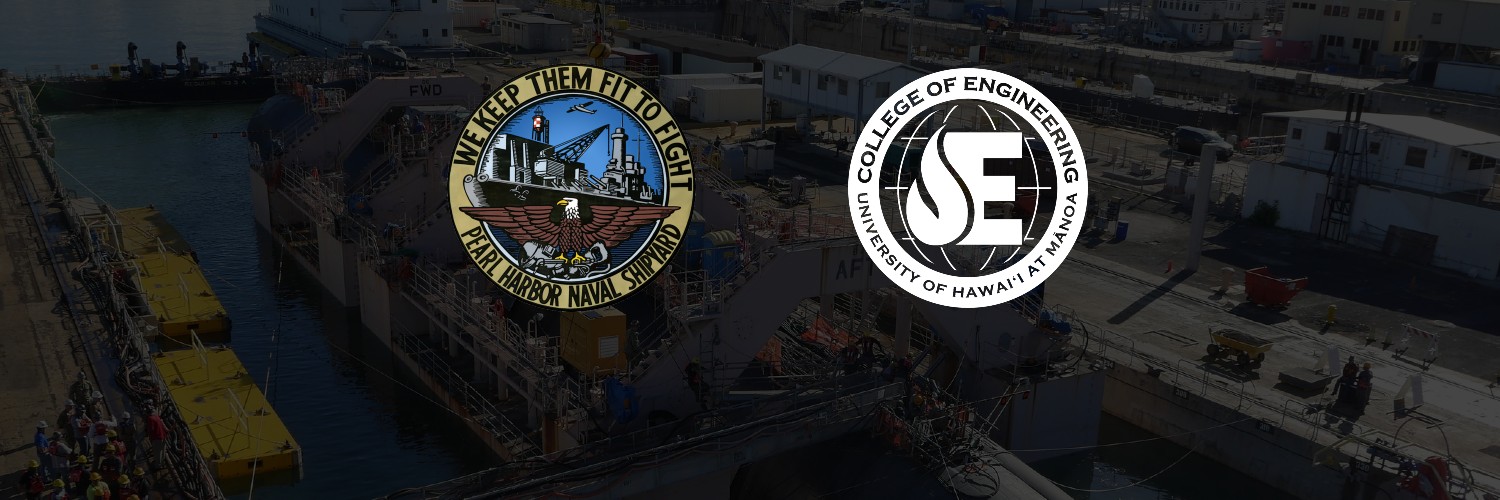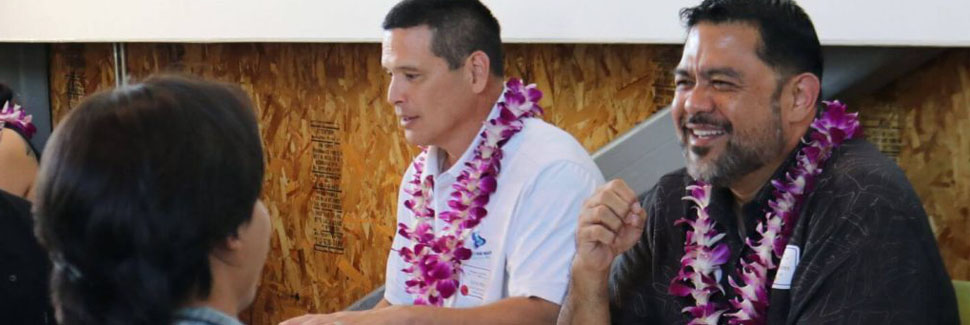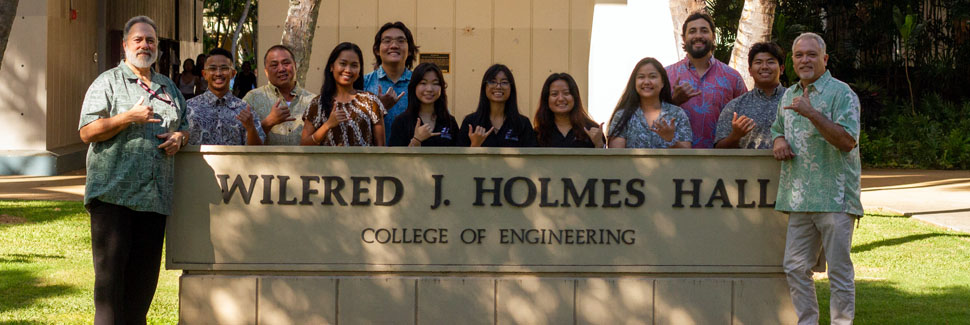
Partners in innovation: Pearl Harbor Naval Shipyard & College of Engineering
A partnership between the Pearl Harbor Naval Shipyard and Intermediate Maintenance Facility (PHNSY & IMF) and the University of Hawaiʻi at Mānoa’s College of Engineering is yielding promising results for both organizations, creating unique opportunities for collaboration and innovation that have the potential for long-range impact.
Formalizing the relationship
The partnership was spearheaded by Dr. Marvin Young, an adjunct professor of Mechanical Engineering (ME) at the College with an impressive resume featuring over 30 years of experience in developing rocket propulsion systems at Aerojet Rocketdyne and a recent term serving on the U.S. Air Force Scientific Advisory Board at the Pentagon. Dr. Young’s experience working with the Department of Defense, along with his top-secret clearance, proved beneficial in helping to strengthen and formalize the relationship between the two entities and put him in a unique position to develop the program. “I recognized early that there was not as much interaction between the College and PHNSY & IMF as there could be, and saw the opportunity to connect the College, with its tremendous capacity of research and base of knowledge, to the work being conducted at PHNSY & IMF,” said Young. ‘The State of Hawaiʻi, likewise, has not yet taken full advantage of the opportunities presented by our state’s military presence. I saw no reason why these two major institutions could not work more closely with one another. The leadership at Pearl Harbor also recognized this potential and were very receptive to our ideas.”
The relationship became official in July 2018 when both parties entered into an Education Partnership Agreement. Since then, they have made progress on multiple fronts.
“We are proud to partner with the University of Hawai’i’s School of Engineering on multiple academic courses as well as several state-of-the-art engineering projects,” said Captain Greg Burton, commanding officer of PHNSY & IMF. “The partnership gives us an opportunity to engage with some of the brightest minds in their respective fields and, in turn, opens up future career opportunities at the shipyard for the students. It’s a win-win for both organizations!”
Course integration
For one, two industry-integrated courses have launched with great success. The first, ME 491-Pearl Harbor Internship, taught by Young, affords students the chance to gain real-world engineering experience by working alongside Pearl Harbor engineers. The course, which started in Fall 2018, accepts 7-8 students each semester and quickly fills up. It allows budding engineers the unique opportunity to work on a critical project in a classified, secure environment – think no cell phones – mentored by a supervisor, many of whom are UH graduates.
“The real-world experience the students gain from this partnership is one of the best examples of hands-on training in systems engineering. Being exposed to the shipyard’s engineering-driven processes coupled with Dr. Young’s instruction is very powerful. It is one thing to read about the importance of systems engineering, but it another to walk into a shipyard building and see it in action,” said Eric Petran, PHNSY & IMF’s Office of Research and Technology Applications Manager.
Student Tarah Aniya, a senior who completed the course last spring, found the hands-on experience to be beneficial. “I learned a lot about what it was like working at the Shipyard: I got the opportunity to work together with different codes and shops so I was able to experience the different working environments at the Shipyard. I also built good relationships with my mentors and other Shipyard workers, which was great because I feel like it helped to open doors for me at the Shipyard should I decide to work there after graduation.”
Young agrees that the course also serves as a recruitment tool: “It’s sort of trial-run for both students and Pearl Harbor engineers to assess one another,” he said, adding that over 50% of the students who have taken the class thus far have been later hired on as full-time employees, and all of those who have been hired are still there today. “We are looking for mutually- beneficial situations, and this is definitely one.”
The second offering, ME 481/482 – Senior Design Project, is a year-long capstone course in its first year of existence that has students tackling non-classified projects put forth by PHNSY & IMF, identifying the problem focus in the first stage and building a prototype in the second. This year’s class, taught by Professor Mehrdad Nejhad, is divided into two teams, each having selected two projects each to complete – one focused on 3D printing and the other working in the robotics space. PHNSY & IMF is providing additional support to students in the way of materials and machinery, producing parts for the project based on drawings the students provide. Students in this course need not secure a military clearance, as they are able to work remotely and do not need to access the base to complete their projects.
Further, the National Security Innovation Network (NSIN) has awarded X-Force designation to all four of this year’s projects, making them part of an initiative that empowers technologists and entrepreneurs to serve their country by solving real-world national security problems in collaboration with the United States military. The X-Force designation opens the door to potential project funding, to be determined once the student’s initial concepts have been developed and presented to NSIN at the end of the Fall semester.
Shared resources
Another exciting element of the partnership is the arrival of a cutting-edge, $250,000 Markforged Metal X 3D printer installed at the College of Engineering. The printer, purchased by the Naval Sea Systems Command (NAVSEA) for educational and research purposes, is part of a three- year joint-use agreement allowing students and faculty to fabricate custom small metal parts for use in research and senior design projects and affording Navy personnel the ability to manufacture replacement parts, especially those that have long lead times or are obsolete, such as metal flanges, valves, brackets and filter housings. The College will unveil the new printer, housed in Holmes Hall 180, on Friday, November 20, 2020 at a grand opening ceremony with Dr. Brennon Morioka, Dean of the College, and Captain Gregory Burton, Commander of PHNSY & IMF.
On the horizon
A final, more intricate collaboration under development is a three-way partnership involving the University of Guam (UOG). Under the terms of this new agreement, currently in a draft stage, students from UOG with a grade-point-average of 3.0 or higher will be able to transfer to UH’s mechanical engineering program in their junior year. They will also be encouraged to enroll in the Pearl Harbor 491-Internship class and will be eligible to apply for paid work at PHNSY & IMF over summers and holidays, with the hope that they will convert to full-time employees at PHNSY & IMF. This symbiotic arrangement will help bring more to UH’s classrooms and serve as an important recruiting tool for NAVSEA’s support of maintenance in Guam.
“We live in a time of incredible and rapid change. Through this partnership, UH’s College of Engineering stays abreast of the Navy’s latest practices and needs. Concurrently, the shipyard will gain insight into UH’s latest technological breakthroughs and solutions. I believe we are already seeing success coming from the merging of the two organizations,” Petran elaborated.
It is these types of arrangements and projects, according to Dr. Young, that will help propel both the College and its partners forward and be able to maximize organizational resources for major impact. “We need a different way of thinking – to operate with a win-win mentality. When we think that way, we can really change the game.”



